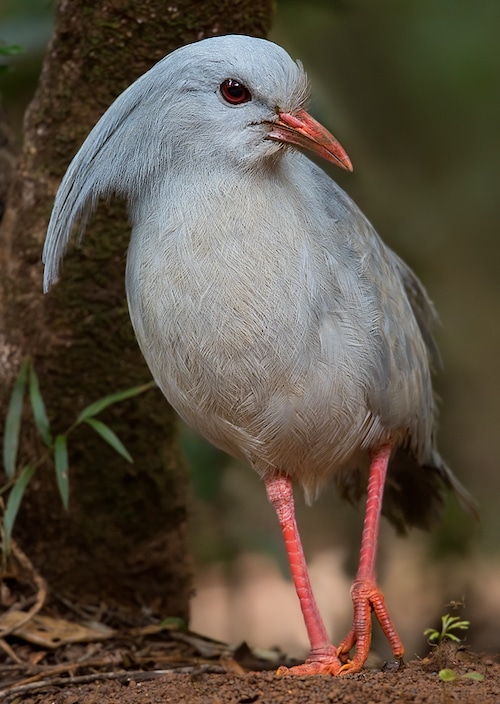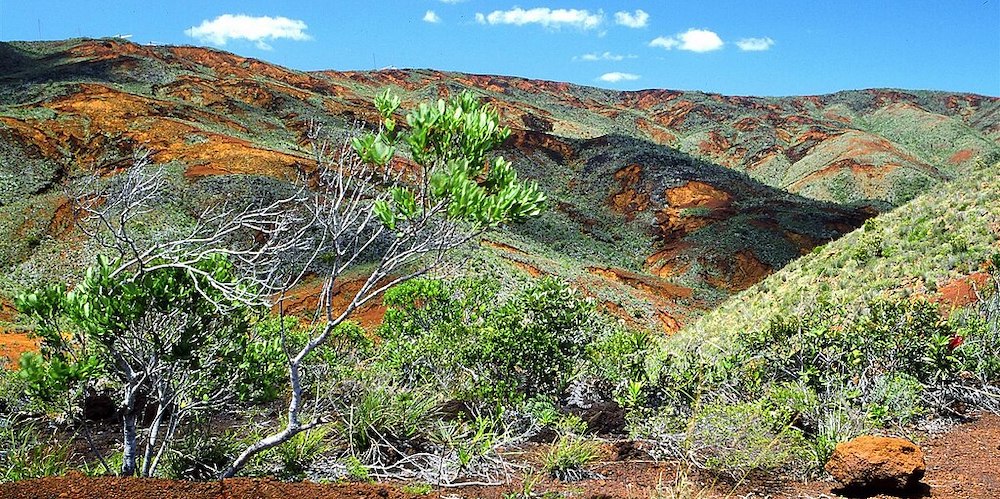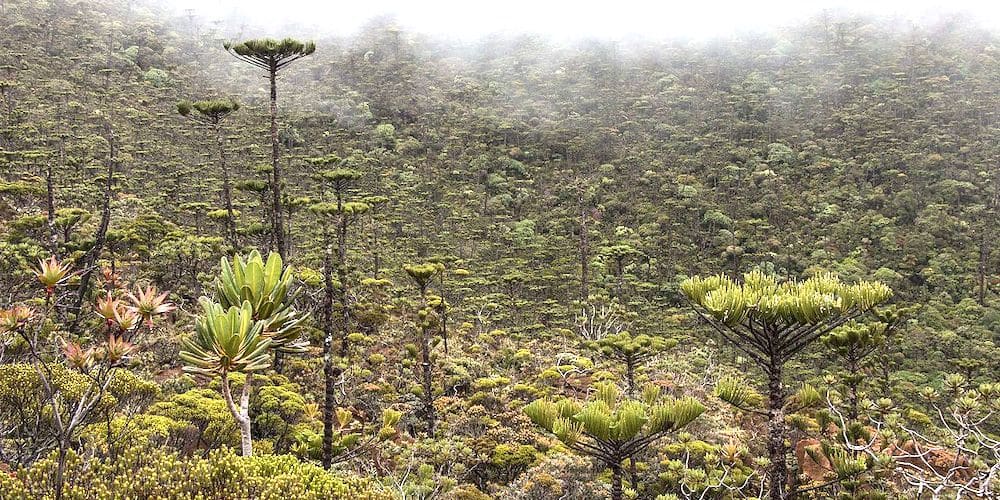New Caledonia

New Caledonia, is an overseas territory of France, made up of a main island (Grande Terre), the Loyalty Islands, and several smaller islands. It is located in the region of Melanesia in the southwest Pacific, 220 km (140 mi) southwest of Vanuatu and 1,210 km (750 mi) east of Australia. At about half the size of Taiwan, it has a land area of approximately 18,500 km2 (over 7,000 square miles). It has a population approaching 300,000 people. The capital and largest city of the territory is Nouméa. New Caledonia is made up of a main island, the Grande Terre, and several smaller islands, the Belep archipelago to the north of the Grande Terre, the Loyalty Islands to the east of the Grande Terre, the Île des Pins (Isle of Pines) to the south of the Grande Terre, the Chesterfield Islands and Bellona Reefs further to the west. The Grande Terre is by far the largest of the islands, and the only mountainous island. It is 350 kilometres (217 miles) in length and 50 to 70 kilometres (31–44 miles) wide. A mountain range runs the length of the island, with five peaks over 1,500 meters (4,900 ft). The highest point is Mont Panié at 5,341 feet. The east coast is covered by a lush vegetation. The west coast, with its large savannahs and plains suitable for farming, is a drier area. Many ore-rich massifs are found along this coast.
The Diahot River is the longest river of New Caledonia, flowing for some 100 kilometres. It has a catchment area of 620 km2 and opens northwestward into the Baie d’Harcourt, flowing towards the northern point of the island along the western escarpment of the Mount Panié. Most of the island is covered by wet evergreen forests, while savannahs dominate the lower elevations. The New Caledonian lagoon, with a total area of 24,000 km2 (9,300 square miles) is one of the largest lagoons in the world. It and the surrounding New Caledonia Barrier Reef was named a UNESCO World Heritage Site in 2008 for its exceptional beauty and marine biodiversity.

Southern Grande Terre – ©User:Bananaflo, CC BY-SA 3.0 via Wikimedia Commons
The climate of the islands is tropical, and rainfall is highly seasonal, brought by trade winds that usually come from the east. Rainfall averages about 60 inches yearly on the Loyalty Islands, 80 inches at low elevations on eastern Grande Terre, and more than 150 inches at high elevations on the Grande Terre. The western side of the Grande Terre lies in the rain shadow of the central mountains, and rainfall averages about 47 inches per year. There are two main seasons – a dry season, and a warm and wet season. The dry cooler months are from April to November with daily temperature ranges from 17-27 ºC. During the wet season (December to March) the temperature can get as hot as 32 ºC. The south-east trade winds temper the heat, and evenings are pleasantly cool. The wet season sees the occasional cyclone hitting the islands.
Birding New Caledonia
New Caledonia has many unique taxa, especially birds and plants. It has the richest diversity in the world per square kilometre. This biodiversity is caused by Grande Terre’s central mountain range, which has created a variety of niches, landforms and micro-climates where endemic species thrive.
New Caledonia is considered one of the world’s most botanically-important, and critically endangered hotspots. Unlike many of the Pacific Islands, which are of relatively recent volcanic origin, New Caledonia is an ancient fragment of the Gondwana super-continent. New Caledonia and New Zealand separated from Australia 85 million years ago and from one another 55 million years ago. This isolated New Caledonia from the rest of the world’s landmasses, and made it a Noah’s Ark of sorts, preserving a snapshot of prehistoric Gondwanan forests. The country still shelters an extraordinary diversity of unique, endemic, and extremely primitive plants and animals of Gondwanan origin. In the past, New Caledonia’s wildlife was even more ancient, almost resembling throwbacks to the Mesozoic. New Caledonia was inhabited by Meiolania, a gigantic turtle resembling a dinosaur ankylosaur the size of a car. Another inhabitant of New Caledonia was Sylviornis, a huge bird with a long, reptilian tail that resembles a dinosaur, probably most closely resembling the oviraptors. The dominant predators of New Caledonia were mekosuchine crocodiles, specifically Mekosuchus. These crocs resembled armored, quadrupedal theropod dinosaurs, and fossil remains suggest they were terrestrial and partly arboreal. All of these creatures died out when humans arrived on New Caledonia.

Cook’s Pine Araucaria columnaris Île des Pins – ©my LifeShow from Paris CC BY 2.0 via Wikimedia Commons
Although the majority of the country’s citizens are unaware of the extraordinary nature of their country’s biological heritage, a few of the country’s animals and plants have become somewhat emblematic in local culture. Among the best known is a hen-sized, flightless bird, commonly-known as the Cagou or Kagu, which has a large crest and an odd barking call. Its song and image are frequently seen as nationally-recognised icons. Another commonly used cultural emblem is the Columnar or Cook’s Pine Araucaria columnaris, an important symbol in Kanak culture. The Niaouli tree (also native to Australia and New Guinea), is of medicinal interest, locally and abroad. Its sap (which contains gomenol, a camphor-smelling compound), is used to treat head colds, and as an antiseptic. It also shows potential to treat other medical ailments. Before the Europeans arrived, there were no mammals other than the Roussette (aka flying fox), a large vegetarian bat, considered a local delicacy. Less well-known by the native population is the fact their country is home to a species of plant, Amborella trichopoda, believed to be genetically close to the ancestor of all flowering plants, or the fact their nation boasts the largest number and diversity of conifer species in the world, per unit of geographic area (a remarkable fact, given that conifers are usually relatively rare in tropical regions).
The islands contain two precipitation zones: Higher-rainfall areas (located on the Loyalty Islands, Isle of Pines (Île des Pins), and on the eastern side of Grande Terre) which support New Caledonia rain forests, and a more arid region, home to the now exceedingly-endangered New Caledonia dry forests, located in the rain shadow on the western side of Grande Terre. Europeans settled on the dry west coast of Grande Terre, leaving the east (as well as the Loyalty Islands and the Isle of Pines) to the Kanaks, and resulting in an ethno-cultural division which coincides with the natural one. Extensive farming by Europeans in the dry forest areas, has caused these forest ecosystems to virtually disappear.

Mont Humboldt’s Unique Flora – ©Nicolas Anger CC BY-SA 4.0 via Wikimedia Commons
It is a vast oversimplification, however, to merely describe New Caledonia’s extremely important, complex and diverse ecology in terms of precipitation zones. Species and ecological diversity is further complicated by soil type (degree and type of mineralization), altitude, and geographic location (for instance, Loyalty Islands and Isle of Pines have flora that is distinct from Grande Terre).
In addition to the remarkable terrestrial environment of New Caledonia, the country is also home to important aquatic ecosystems. Its freshwater ecology also evolved in long isolation, and the New Caledonia rivers and streams are home to many endemic species. Moreover, the New Caledonia Barrier Reef, which surrounds Grande Terre and Île des Pins, is the second-largest coral reef in the world after Australia’s Great Barrier Reef, reaching a length of 1,500 kilometres. Like its terrestrial counterpart, the Caledonian reef system has great species diversity, is home to endangered dugongs Dugong dugong, and is an important nesting site for the Green Sea Turtle Chelonia mydas. The Nautilus is a living-fossil species, once common during the age of the dinosaurs, and survives today in the waters surrounding New Caledonia. UNESCO listed New Caledonia Barrier Reef on the World Heritage List (2008).
There are, perhaps, 27 endemic bird species… only in doubt because a number are critically endangered and several not seen for some years and so may be extinct. The greatest attraction for birders is the Kagu Rhynochetos jubatus as it is not just an endemic species, but also the soul surviving member of the Rhynochetidae family, the only other member of which is known only from fossil records.
-
Wikipedia
GNU Free Documentation License
https://en.wikipedia.org/wiki/New_Caledonia
-
Number of bird species: 227
(As at December 2024)National Bird: Kagu Rhynochetos jubatus
Number of endemics: 27
Kagu Rhynochetos jubatus
New Caledonian Imperial-pigeon Ducula goliath
Cloven-feathered Dove Drepanoptila holosericea
New Caledonian Owlet-nightjar* Aegotheles savesi
New Caledonian Rail* Gallirallus lafresnayanus
New Caledonian Buttonquail* Turnix novaecaledoniae
White-bellied Goshawk Accipiter haplochrous
Horned Parakeet Eunymphicus cornutus
Ouvea Parakeet Eunymphicus uvaeensis
New Caledonian Lorikeet* Charmosyna diadema
New Caledonian Parakeet Cyanoramphus saiseti
Crow Honeyeater Gymnomyza aubryana
New Caledonian Friarbird Philemon diemenensis
New Caledonian Myzomela Myzomela caledonica
Barred Honeyeater Gliciphila undulata
New Caledonian Cuckooshrike Edolisoma anale
New Caledonian Whistler Pachycephala caledonica
New Caledonia Streaked Fantail Rhipidura verreauxi
New Caledonian Crow Corvus moneduloides
Yellow-bellied Flyrobin Cryptomicroeca flaviventris
New Caledonian Grassbird Cincloramphus mariae
Small Lifou White-eye Zosterops minutus
Green-backed White-eye Zosterops xanthochroa
Large Lifou White-eye Zosterops inornatus
Striated Starling Aplonis striata
New Caledonian Island-Thrush Turdus xanthopus
Red-throated Parrotfinch Erythrura psittacea* Probably Extinct
-
Avibase
PDF ChecklistThis checklist includes all bird species found in New Caledonia , based on the best information available at this time. It is based on a wide variety of sources that I collated over many years. I am pleased to offer these checklists as a service to birdwatchers. If you find any error, please do not hesitate to report them. -
Wikipedia
Annotated ListThis is a list of the bird species recorded in New Caledonia. The avifauna of New Caledonia include a total of 226 species, of which 28 are endemic, and 13 have been introduced by humans. -
eBird
PDF ChecklistThis checklist is generated with data from eBird (ebird.org), a global database of bird sightings from birders like you. If you enjoy this checklist, please consider contributing your sightings to eBird. It is 100% free to take part, and your observations will help support birders, researchers, and conservationists worldwide.
-
Birds of Melanesia: Bismarcks, Solomons, Vanuatu and New Caledonia
| By Guy Dutson | Christopher Helm | 2011 | Paperback | 447 pages | 75 colour plates | colour photos | colour maps | black & white illustrations | tables | ISBN: 9780713665406 Buy this book from NHBS.com -
Field Guide to the Birds of the Solomons, Vanuatu and New Caledonia.
| By Chris Doughty, Nicholas Day & Andrew Plant | Christopher Herm | 1999 | Paperback | 206 pages, 91 colour plates, 340 colour distribution maps | Out of Print | ISBN: 9780713646900 Buy this book from NHBS.com
-
Bird Conservation New Caledonia
Facebook PageBird Conservation New Caledonia est une association qui mène des actions de conservation sur les oiseaux protégés : restauration des habitats dégradés, lutte contre les espèces invasives, mise en place de colonies artificielles... -
Société Calédonienne d'Ornithologie
WebsiteProtection des oiseaux de la Nouvelle-Calédonie…
-
PP Grandes Fougeres
WebpageSatellite ViewAt the crossroads of Farino, Moindou and Sarraméa, the Giant Fern Park is a welcoming and people-friendly environment, perfect for walking or riding mountain bikes. You can create your own itineraries from the many walking trails in the 4 500 hectare tropical rain forest, which is set in an altitude of between 400m and 700m... -
PP Riviere Bleue
InformationSatellite ViewThe Blue River Provincial Park was created in 1980 and stretches over 9,045 hectares. Lumber and mining operations at the turn of the century have left marks that are still visible. Learn more about the history of New Caledonian in this unique natural environment, where you can view the scrub that has grown back in the mining zones and the rainforest...
-
Birding Ecotours
Tour OperatorIt boasts of 3,500 varieties of plants, of which three-quarters are endemic, 4,300 species of terrestrial animals, 200 species of birds (including the Kagu), 1,000 species of fish, and 6,500 marine invertebrates. -
Caledonia Birds
Tour OperatorIsabelle will guide you to the best places to watch caledonian birds and especially the Kagu. -
Kiwi Wildlife Tours
Tour OperatorBirds & birdwatching in the South Pacific Islands -
NCFS
Tour OperatorNew Caledonia is a territory where you will observe rare and/or endemic birds (sea, bush and dry forest birds). Some species nest on sheltered lagoon's islands. Some of these islands are strictly
-
2016 [07 July] - David Hoddinott & Rich Lindie - Samoa, Fiji, Vanuatu & New Caledonia
PDF Report...over a dozen of the region's endemics, including BarredHoneyeater, New Caledonian Friarbird, South MelanesianCuckooshrike, Streaked Fantail, Melanesian Flycatcher,New Caledonian Crow and Yellow-bellied Flyrobin. Furtherdown the road, outside the reserve... -
2017 [07 July] - Erik Forsyth & Rich Lindie
PDF Reporthisyear'stourtothesouth-westPacificproved,yetagain,thatnotonlyistheregionabirdinghotspot,butthingsarerapidlyimprovinginthetourismandtravelsector.Indeed,weexperiencedverylittleoftheoncenotoriousflightdelaysthatplaguedtheregion,dinedinseveralfinerestaurants,andliveditupinsometrulywonderfulaccommodations.Thebirds,ofcourse,wereasspectacularasalways,andourexploitssecuredusgreatsightingsofnolessthan78oftheregion'sendemics,includingsuchmegasasKagu,HornedParakeet,OrangeFruitDoveandMao! -
2018 [11 November] - New Caledonia & Fiji, with Vanuatu & Samoa
PDF ReportThe unique Orange Fruit Dove was the undisputed highlight of our very enjoyable foray to the Melanesian islands of Vanuatu and New Caledonia and the Polynesian islands of Fiji and Samoa. These little dots sprinkled about in the western Pacific Ocean hold an amazing variety of endemics and specialities and on our recent trip we managed to see the majority of these. -
2018 [12 December] - Chris Lotz
PDF ReportThis short and highly successful New Caledonia set departure group tour followed our Western Australia tour. The tour started in Nouméa and concluded back there. The tour focused on (and was successful in) finding all of the endemic birds found on Grande Terre, the main and largest island of New Caledonia, as well as several regional endemic species and a number of distinct subspecies that may warrant full species status in the future. -
2019 [01 January] - Valentine Moser
ReportKagu is the main attraction of this French overseas territory, as it is the only member of its family Rhynochetidae and truly a unique bird! It is quite straightforward in the Blue River National Park. -
2020 [01 January] - Mark Sutton
PDF ReportThis trip was taken at the end of a 9-week sabbatical for me and a 6-week sabbatical for Linda. We had both toured New Zealand for 4 weeks prior to this and I had been on a Sub Antarctic cruise for 18 days before Linda’s arrival. -
2023 [05 May-08 August] - Eric Shaw
PDF ReportThe birds were fantastic! Kagu did not disappoint, and we had several nice views at two different locations. We got lucky with the New Caledonian Thicketbird (2 birds!), which perched up (briefly) for some nice views. It was also a treat to watch New Caledonian Crow, one of the smartest birds in the world (makes and uses tools).
-
Status Protected 2022 Protecting the Premier Biodiversity Hotspot of New Caledonia
InformationWithin the montane cloud forests of Mount Panié, the highest mountain in the Pacific island chain of New Caledonia, resides the Mount Panié Kauri pine. -
Endemic Birds of New Caledonia
Website22 species of endemic birds are found on New Caledonia with a further 9 species of very restricted range -
New Caledonia Sparrowhawk Accipiter haplochrous
WikipediaSpecies account -
Ouvea Parakeet Eunymphicus cornutus uvaensis
WebsiteSpecies account and image

